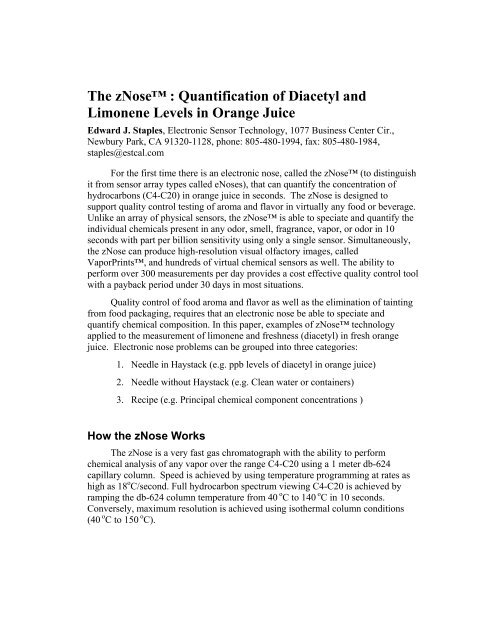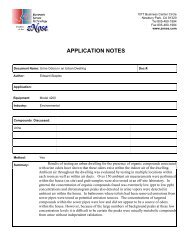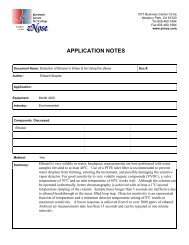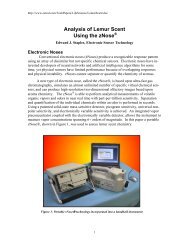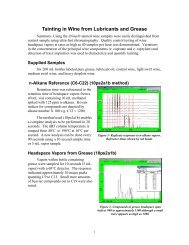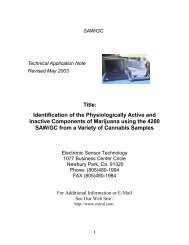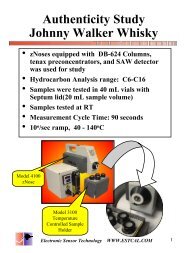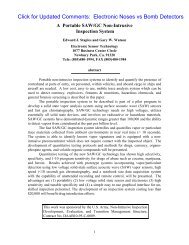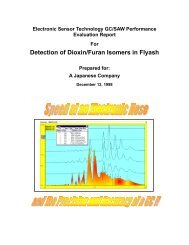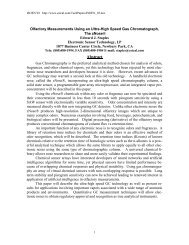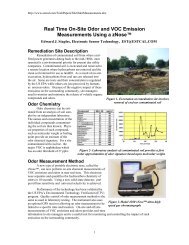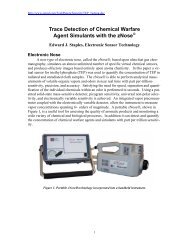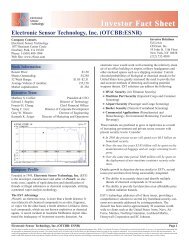The zNose - Electronic Sensor Technology
The zNose - Electronic Sensor Technology
The zNose - Electronic Sensor Technology
Create successful ePaper yourself
Turn your PDF publications into a flip-book with our unique Google optimized e-Paper software.
<strong>The</strong> <strong>zNose</strong> : Quantification of Diacetyl and<br />
Limonene Levels in Orange Juice<br />
Edward J. Staples, <strong>Electronic</strong> <strong>Sensor</strong> <strong>Technology</strong>, 1077 Business Center Cir.,<br />
Newbury Park, CA 91320-1128, phone: 805-480-1994, fax: 805-480-1984,<br />
staples@estcal.com<br />
For the first time there is an electronic nose, called the <strong>zNose</strong> (to distinguish<br />
it from sensor array types called eNoses), that can quantify the concentration of<br />
hydrocarbons (C4-C20) in orange juice in seconds. <strong>The</strong> <strong>zNose</strong> is designed to<br />
support quality control testing of aroma and flavor in virtually any food or beverage.<br />
Unlike an array of physical sensors, the <strong>zNose</strong> is able to speciate and quantify the<br />
individual chemicals present in any odor, smell, fragrance, vapor, or odor in 10<br />
seconds with part per billion sensitivity using only a single sensor. Simultaneously,<br />
the <strong>zNose</strong> can produce high-resolution visual olfactory images, called<br />
VaporPrints, and hundreds of virtual chemical sensors as well. <strong>The</strong> ability to<br />
perform over 300 measurements per day provides a cost effective quality control tool<br />
with a payback period under 30 days in most situations.<br />
Quality control of food aroma and flavor as well as the elimination of tainting<br />
from food packaging, requires that an electronic nose be able to speciate and<br />
quantify chemical composition. In this paper, examples of <strong>zNose</strong> technology<br />
applied to the measurement of limonene and freshness (diacetyl) in fresh orange<br />
juice. <strong>Electronic</strong> nose problems can be grouped into three categories:<br />
1. Needle in Haystack (e.g. ppb levels of diacetyl in orange juice)<br />
2. Needle without Haystack (e.g. Clean water or containers)<br />
3. Recipe (e.g. Principal chemical component concentrations )<br />
How the <strong>zNose</strong> Works<br />
<strong>The</strong> <strong>zNose</strong> is a very fast gas chromatograph with the ability to perform<br />
chemical analysis of any vapor over the range C4-C20 using a 1 meter db-624<br />
capillary column. Speed is achieved by using temperature programming at rates as<br />
high as 18 o C/second. Full hydrocarbon spectrum viewing C4-C20 is achieved by<br />
ramping the db-624 column temperature from 40 o C to 140 o C in 10 seconds.<br />
Conversely, maximum resolution is achieved using isothermal column conditions<br />
(40 o C to 150 o C).
Figure 1-<br />
Testing Limonene in Orange Juice<br />
Step 1- Clear <strong>zNose</strong> using Air Blank and 10ps-0<br />
Step 2- Create orange juice standard<br />
Step 3- Preconcentrate headspace vapors from orange juice standard<br />
Step 4- Analyze orange juice with <strong>zNose</strong> and 10ps-0 method<br />
Step 5- Clear <strong>zNose</strong> using Air Blank and 10ps-0 method
Testing for Diacetyl in Orange Juice<br />
Step 1- Air Blanks using 10ps-0 method (initialization of <strong>zNose</strong>)<br />
Step 2- Create diacetyl/orange juice standards<br />
Step 3- Tenax absorber air blanks (170 o C) using 10ps-0 method<br />
Step 4- Cool Tenax absorber to room temperature<br />
Step 4- Preconcentrate headspace vapors from diacetyl/orange juice standard<br />
Step 5- Dry tenax absorber<br />
Step 6- Raise tenax absorber to 170 o C<br />
Step 7- Analyze tenax vapors with <strong>zNose</strong> and 0ps-0 method<br />
Step 8- Tenax absorber air blanks (170 o C) using 10ps-0 method


